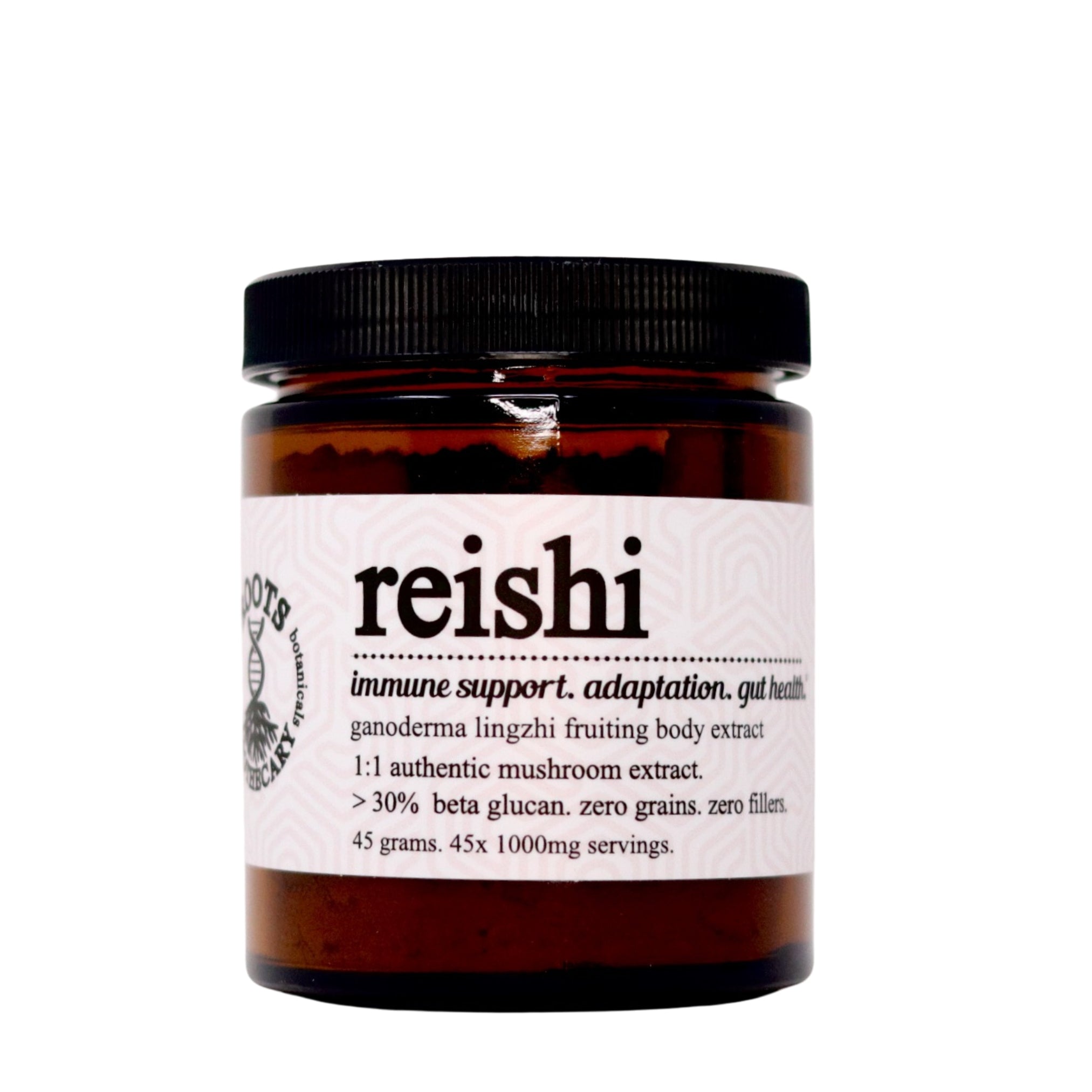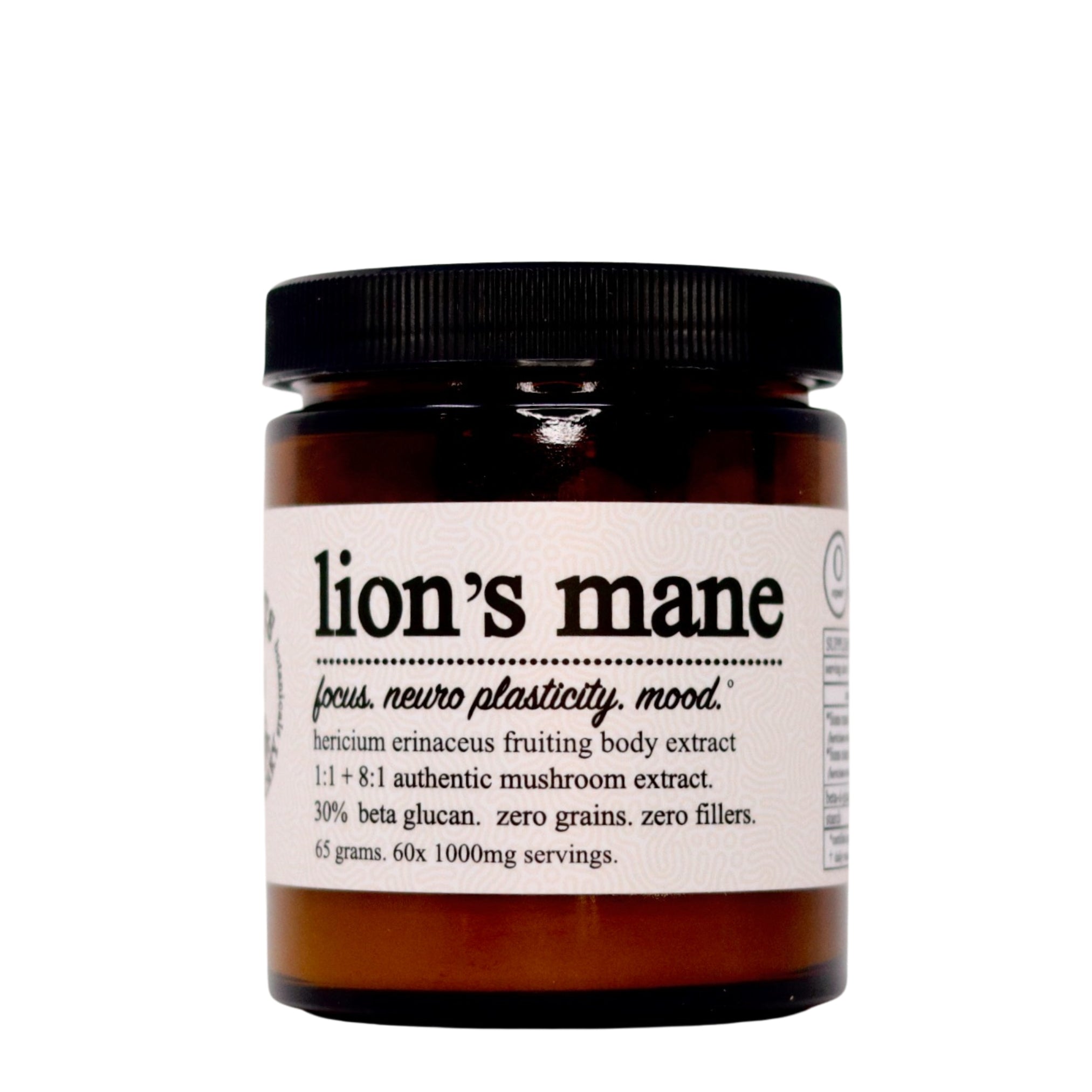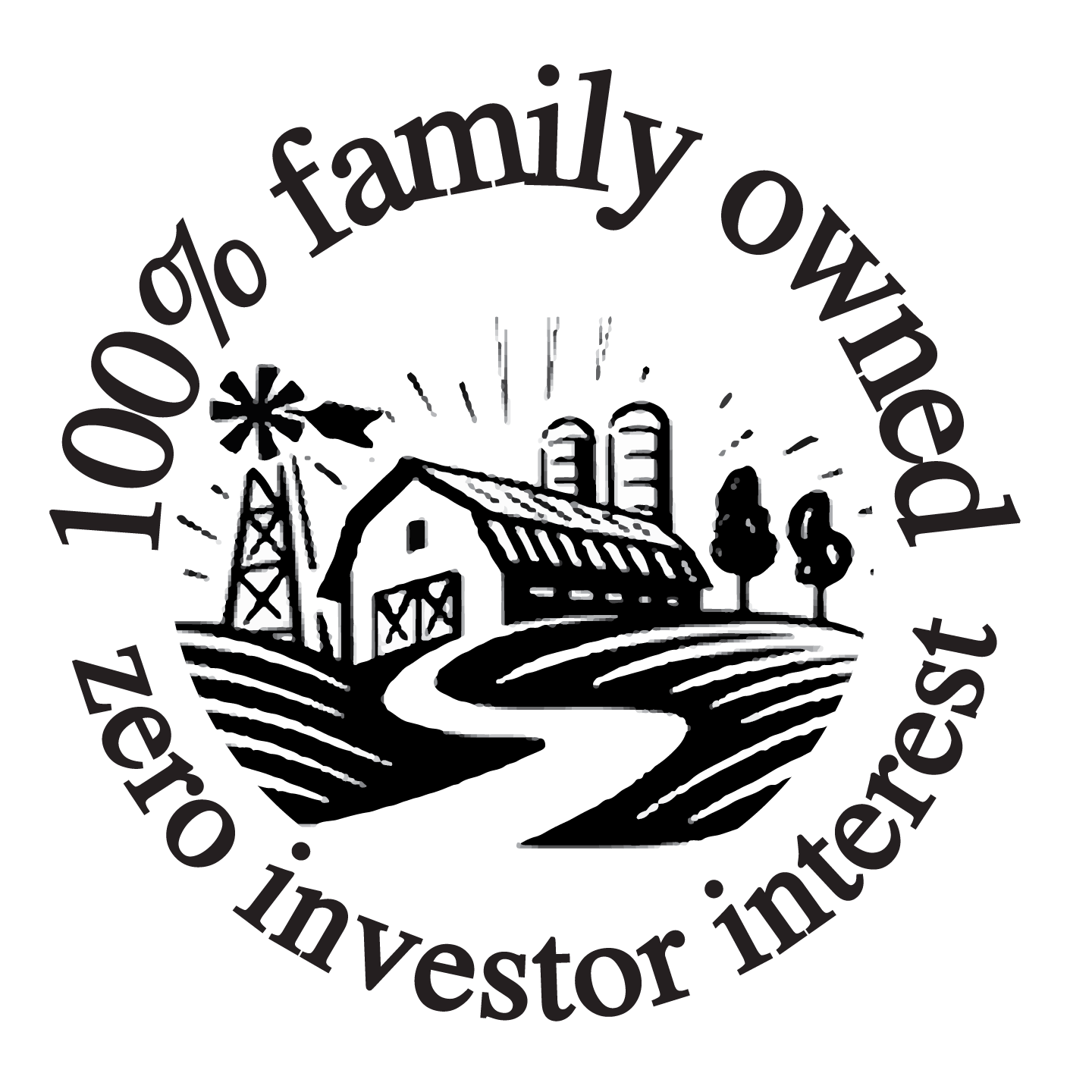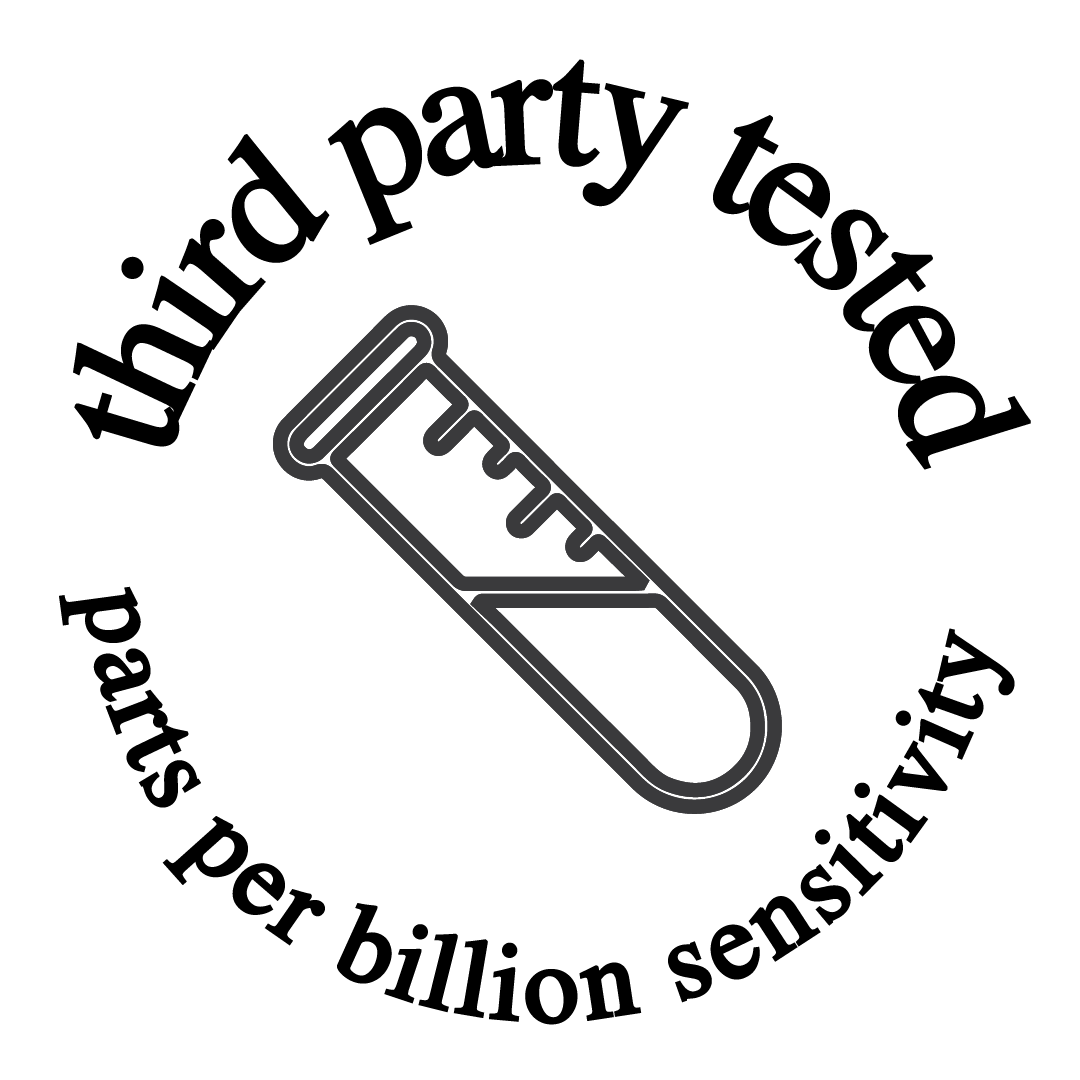this set is for people who already have a mushroom routine dialed in, or are in the process of dialing in a specific routine. typically, people who buy these stacks are a little more knowledgeable about mushrooms in general and don't mind a little prep (smoothie, tea, coffee,
100% fruiting body mushroom extracts.
we understand the most reliable therapeutic potency comes from 100% fruiting body extracts. this is where you get the highest concentrations of beta-glucans that modulate the immune and inflammatory response and active compounds like the published and famed erinacines and hericenones that give lion's mane its neuroprotective, neurotropic and neuroplastic properties.
if you want the highest and most consistent therapeutic potential, fruiting body is the way to go.
>30% beta-d-glucan <5% starch | zero grain. zero filler. zero preservatives.
lion's mane mushroom.
hericium erinaceus.
focus + clarity. neuroplasticity. mood. inflammation. brain health.
roots apothecary lion's mane fruiting body extract. >25% beta-d-glucan <5% starch
lion’s mane is one of the most mainstream and popular mushrooms on the market. shown to stimulate neuroplasticity, memory, focus and overall brain health, lion’s mane contains two special compounds that stimulate the growth of brain cells: hericenones and erinacine.
in addition, animal studies have found lion’s mane extract can improve the functioning of the hippocampus, a region of the brain responsible for processing memories and emotional responses. this may explain the effects of lion’s mane on improved mood, decreased resistance to new habit forming and influence on depression. lion’s mane may also help prevent neuron damage caused by amyloid-beta plaques, which is an area of interest for alzheimer's and dementia therapy.
cordyceps mushroom.
cordyceps militaris.
physical + mental endurance. inflammation.
roots apothecary cordyceps fruiting body extract. >25% beta-d-glucan <5% starch
cordyceps is known for supporting mental and physical performance and is especially popular in the athlete community. this mushroom (which is technically not a mushroom) supports healthy adrenal function through its stress-protective effects (as an adaptogen) while increasing atp and vo2 (peak oxygen uptake during exercise). enhanced oxygen utilization is attributed to cordyceps ability to increase vasodilation (widening blood vessels) and blood flow. cordyceps is highly recognized for helping improve acute and chronic fatigue and is often paired with lion’s mane to promote creative focus.
studies have associated cordyceps supplementation with increasing activity of catalase (cat), superoxide dismutase (sod) and glutathione peroxidase (gpx) making it a powerful anti-oxidant as well.
reishi mushroom.
ganoderma lingzhi.
immune support. stress. liver + kidneys. overall wellbeing.
roots apothecary reishi fruiting body extract. >30% beta-d-glucan <5% starch
similar to chaga, reishi is very diverse in benefits with high anti-oxidant, anti-inflammatory, anti-anxiety and immune-boosting properties. reishi is considered an adaptogen for its ability to calm the fight or flight response, strengthening resilience in both physically and mentally stressful situations.
reishi is additionally known for its potential benefits to the kidneys and liver by reducing inflammation and reducing erosion of the nephron outer membrane (decreasing kidney permeability).
reishi’s immune-supporting properties are well-rounded, including the promotion of innate immune function, humoral immunity, and cellular immunity. in particular, reishi extract may improve the function of b and t lymphocytes, dendritic cells, macrophages, and natural killer cells. beta-d-glucans are the polysaccharides present in reishi that are responsible for these immune-supporting properties.
a deeper dive into mushrooms
a little picture of a mushroom to help visualize the following explanation.
(example of oat substrate method)
fruiting body
• contains 2x-3x higher concentrations of beta-glucans and active compounds.
• contains no grain substrate.
mycelium biomass
• an inseparable block of oat substrate and mycelium network.
• contains 30% - 70% oats and 30% - 80% mycelium. the entire block is processed for product making and is significantly weaker in beta-glucan and active compounds than the fruiting body.
understanding fruiting body vs mycelium biomass.
this is important.
how mushrooms are grown.
to grow a mushroom, spores are injected into a substrate (the material mushrooms grow on — e.g. soil, grains, or wood pulp). spores grow into hyphae and join each other to create a mycelium network that expands through the substrate and extracts nutrients. when a strong mycelium network is established, a fruiting body grows from the surface to spread more spores. when you think of mushrooms, you probably picture the fruiting body (long stem and bulbous cap). however, oftentimes 90% or more of a mushroom's biomass is actually mycelium, and while mycelium is a brilliant network and the living organism of the mushroom, it contains far less beta-glucan and active compounds than the fruiting body.
if you buy a product that uses mycelium, you’re probably purchasing more grain filler than mushroom.
most commercial mushroom growers use a grain substrate. as mycelium expands, it attaches and becomes inseparable from the grain to create one product called mycelium biomass. there’s a big problem with this.
how much mycelium and how much grain is in the biomass?
this varies widely and depends entirely on the grower. if mycelium biomass is pulled for product making as soon as mycelium expands through the grain, you will get far more grain than mycelium. if the grower allows this process to continue, the amount of mycelium will increase. however, even at its strongest, mycelium biomass will contain anywhere between 30%-40% grain. mycelium pulled early for faster product making may have anywhere from 40%-70% grain content.
for example, this means 1000mg reishi mushroom in the form of mycelium biomass can be anywhere from 300mg-700mg grain. depending on the price, you may overpay tremendously for this product and you definitely won't receive the therapeutic potential of reishi mushroom.
here’s the ultimate problem. the product label will probably just say “1000mg reishi mushroom”, without any indicator of whether it's a mycelium or fruiting body. if it’s mycelium, you probably won't be informed about how much pure mycelium you’re getting and how much grain you’re getting in that 1000mg serving.
most growers use oat substrate because oats are high in fiber and have measurable amounts of beta-glucans. since beta-glucan content is a common and relatively accurate measure of mushroom potency, growing on oats can make lab tests and nutrition charts for mycelium products look stronger.
why would anyone sell a product that’s mostly grain filler and let you believe it’s a highly therapeutic mushroom product? the answer is the same across all industries, they either don’t know or don't care. both answers are part of the same problem.
a product maker selling reishi mushrooms can source mycelium biomass for about $25 or they can buy the same amount of fruiting body mushrooms for $75. mycelium is much cheaper, faster to grow, easier to get, and can be called “reishi mushroom” on a product label. if you’re an individual or company that's primarily incentivized by making money on a trending health product, you will probably opt for the cheaper and easier source of reishi mycelium biomass. there are plenty of companies out there using authentic reishi fruiting bodies and labeling products transparently, but there are arguably more that are not. as a consumer, you need to know the difference.
there are reputable companies selling appropriately priced mycelium biomass and clearly indicating its mycelium. mycelium biomass has health benefits if grown by a reputable company and is priced at 2x-3x multiples less than fruiting body extracts.















